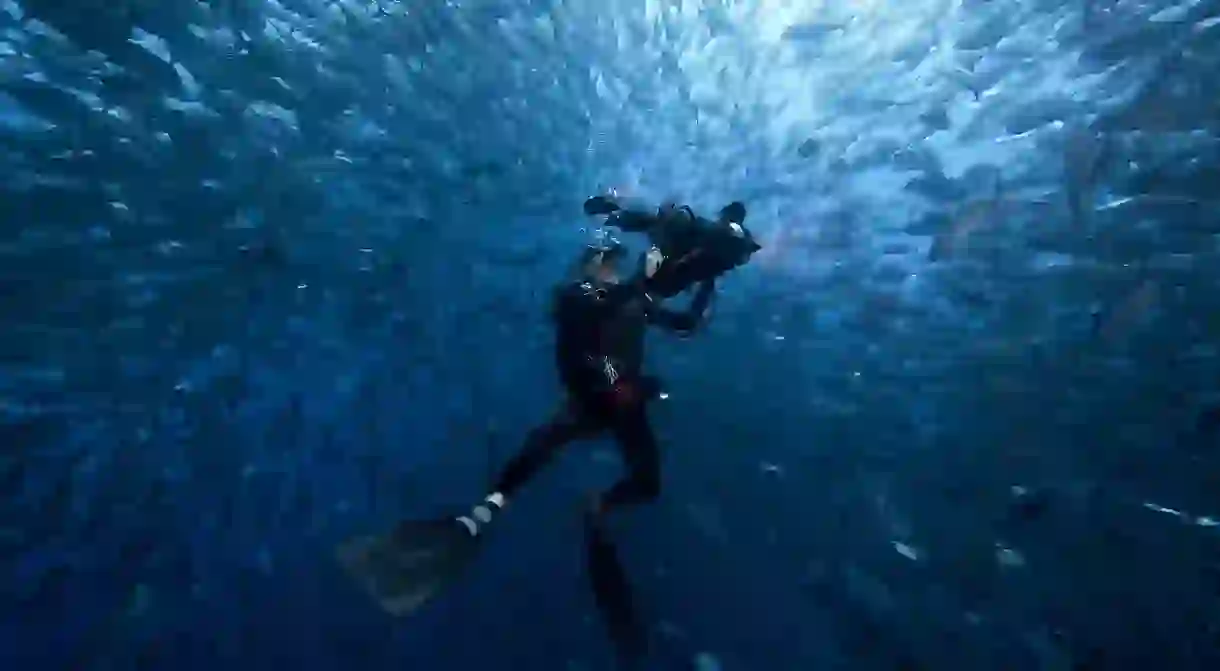An Interview With Underwater Photographer Mok Wai Hoe

Meet Mok Wai Hoe, a businessman running an industrial electrical business in Singapore who – despite a hectic work life – spends his spare time flying around the world to take serious underwater photography. His photos cover creatures such as Pacific Manta Ray from Mexico, sardines from the East Coast of South Africa, sharks from the Bahamas, and corals from islands in South East Asia. The photos have been featured in National Geographic and named as Ocean Geographic‘s ‘Pictures of the Year.’ In 2015, Mok was also inducted in the Ocean Artists Society which aims to raise greater awareness to conserve nature through ocean artists. Here, he shares his journey into the world of photography, and the tricks and difficulties in taking pictures under the ocean.
How did you get into underwater photography?
I bought my first underwater camera about six years ago, a year after I obtained my scuba diving license. It was a compact point-and-shoot camera encased in a plastic camera housing. I wanted to capture images of the underwater world, just to show my family. It was in Thailand, diving at Koh Lipe when I took my batch of photographs. The photographs didn’t turn out well! Today, I use them as examples of how not to take underwater photographs in my workshops. However, among the 50 poorly taken photographs, there was one that stood out. It was a fluke shot, but that photograph gave me such a sense of accomplishment that I decided to take underwater photography seriously.

What was the most unforgettable experience?
In 2012, I participated in a shark diving expedition in the Bahamas. The objective of the expedition was to capture images of several species of sharks in an attempt to change attitudes towards the largely misunderstood creatures. We dived three to four times a day at the same dive site over nine days. We used a plastic crate filled with bait to attract the sharks. Each time, we were surrounded by over 20 sharks; from Caribbean reef sharks to nurse sharks and lemon sharks. The most coveted of them all was the tiger shark. Growing up to four meters in length, the tiger shark has a notorious reputation, second only to the great white. We had an incident where we encountered three tiger sharks during one dive. As the tiger sharks got quite comfortable with the divers, they started to get progressively closer to us. One in particular, decided to attack and broke open the plastic bait crate. The dive suddenly turned chaotic when all the sharks went into a frenzy. The sand was stirred up and the sharks were biting each other. We were in a precarious situation because the sharks could no longer see us and we smelled like bait. We frantically fled the dive site and hurried back onto the boat. It was quite nerve-racking! We waited for two hours until our heartbeats settled and the sharks were calm again before getting back into the water to continue the shoot.

What are some of the most interesting places you have taken these underwater photos?
I had the privilege to dive in some really exotic places. The ones that left an impression certainly was the sardine run in South Africa, where we dived amongst thousands of sardines and watched dolphins, sharks and birds (gannets) feed off them. I have crossed the Pacific Ocean for 24 hours from Costa Rica to dive at the Cocos Island, where I got the opportunity to photograph a school of 200 hammerhead sharks.
Last year, I dived at the Socorro Islands, 30 hours from Mexico to capture images of Pacific manta rays. These are the largest rays in the world, with a wing span that stretches up to seven meters. I’m looking forward to my trip to Tonga in September, where hopefully I will be able to capture images of humpback whales.

What are the difficulties in taking underwater photography and could you share with us some tips for taking good photos?
What makes underwater photography so challenging is also what makes it engaging.
First there is a need to develop good scuba diving skills. We talk a lot about good buoyancy control, which is the skill to control how you manoeuvre in the water. There are inherent dangers in scuba diving, and one needs the experience to manage these risks while handling photography equipment.
Then, there is the underwater photography itself. Camera systems are designed for land photography, hence any automatic settings perform poorly underwater. For underwater photography, all settings have to be done manually. There is a whole lot of fiddling around to do to capture a good image; from deciding the amount of light to let into the camera to composing the photograph – and all this is done in a very short amount of time. The window of opportunity to capture a moving shark or a frolicking dolphin can be just a matter of seconds.
There aren’t really any shortcuts to taking good underwater pictures. It takes a lot of time studying, researching and practice. It helps if you have someone experienced to share some of the knowledge. My advice to aspiring underwater photographers is to first get the basics right, attend lots of photography workshops and then go out and shoot.

To view more of Mok’s photography including photos of wildlife land animals and snow monkeys, visit his portfolio ‘Nature’s Palette by Mok Wai Hoe‘ or his Instagram page.













